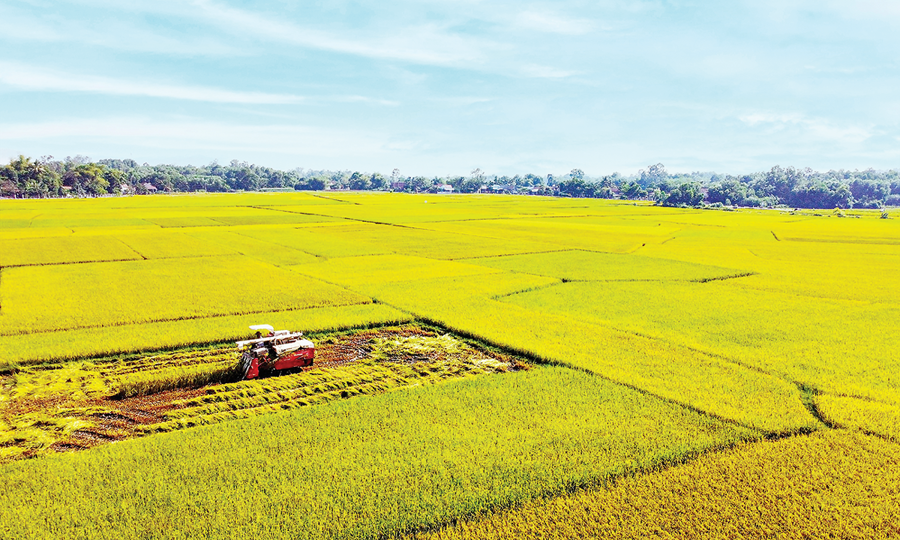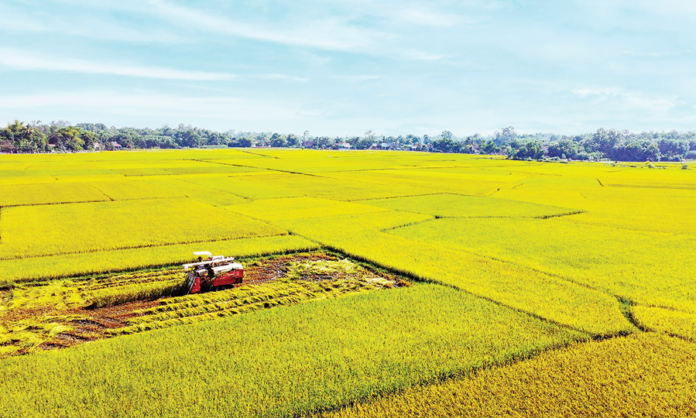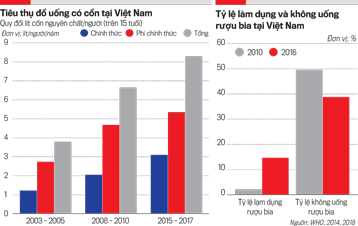The primary activity is the application of the alternate wetting and drying (AWD) irrigation method, which reduces methane emissions from anaerobic processes. This method decreases water usage in systematically irrigated rice fields without altering the cropping cycle or affecting soil carbon maintenance.
AWD reduces water consumption by 15-35%, surpassing the minimum 5% requirement. The project complies with existing laws, does not alter natural ecosystems within ten years before the starting point, and does not negatively impact off-season management.
An Giang’s VCS 5469 project is technically, legally, and environmentally eligible for validation under the Verified Carbon Standard (VCS). The study demonstrates the potential for advanced water management in rice cultivation to contribute effectively to greenhouse gas emission reduction goals in agriculture.
APPLICATION OF LOW-EMISSION AWD TECHNOLOGY IN RICE PRODUCTION
Rice is a crucial food staple globally, ensuring food security for over half of the world’s population. Regions like Asia, Latin America, and Africa heavily rely on rice as a food source. Paddy field cultivation in low-lying plains has become the primary production method, with over 90 million hectares of rice fields worldwide, contributing to approximately 75% of global rice production. This maintains food supply stability and balance in many developing countries.
In Vietnam, the estimated rice cultivation area in 2024 was 7.13 million hectares, with a production estimate of about 43.46 million tons. This positions Vietnam as the fifth-largest rice producer and the third-largest rice exporter worldwide. The significance of rice production transcends national borders, contributing to global food security amid population growth and complex climate change dynamics. Vietnam is now considered a strategic country in maintaining stable rice supplies for numerous countries, especially in Asia and Africa.

While rice cultivation provides economic value and food security, it is also a significant source of greenhouse gas emissions. Methane emissions from rice fields result from prolonged waterlogging, creating anaerobic conditions conducive to organic matter decomposition. Emissions from this activity are estimated to account for approximately 1.5% of total global greenhouse gas emissions. In rice-growing countries like Vietnam, emission rates can be significantly higher than the global average. In Vietnam, rice cultivation is responsible for about 48% of agricultural greenhouse gas emissions and 75% of agricultural methane emissions.
In addition to greenhouse gas emissions, rice cultivation consumes a substantial amount of irrigation water. According to studies, water used for rice irrigation accounts for 34-43% of total water usage in agricultural irrigation activities. With the intensifying impacts of climate change and increasing water scarcity, the pressure on traditional cultivation systems is mounting. Maintaining continuous waterlogging will struggle to meet water resource efficiency requirements and greenhouse gas emission reduction goals in agriculture.
The alternate wetting and drying irrigation solution has been studied and applied to enhance water use efficiency and significantly reduce methane emissions from rice fields. This method avoids continuous waterlogging and allows the field to dry briefly before re-irrigation. Research indicates that AWD can reduce methane emissions by up to 47% compared to traditional cultivation methods. Implementing water-saving irrigation practices enables farmers to maintain or slightly increase rice yields without increasing water usage, demonstrating the feasibility of this approach in low-lying areas with abundant irrigation water but threatened by climate change.
An Giang is located in the Mekong Delta region, with geographical coordinates ranging from 105°70′ to 105°12′ east longitude and 10°30′ to 10°52′ north latitude. The area primarily consists of agricultural ecosystems with rice fields, industrial crops, cash crops, and a portion of forest land. There is a shift towards cultivating high-value crops and aquaculture. Urbanization has led to some conversion of agricultural land. The tropical monsoon climate, with year-round heat and humidity, influences the farming calendar.
An Giang has a dense network of rivers vital for irrigation but faces saltwater intrusion risks during the dry season. The terrain is predominantly flat, with the Seven Mountains in the west. The soil is fertile and includes acidic sulfate soils that require amelioration. The region boasts diverse vegetation, notably the Tram Chim National Park, which holds high ecological and tourism value.
The AWD solution has proven highly effective in water conservation, reducing water usage by 15-35% compared to historical averages. Studies have shown that when properly implemented, this technique does not compromise rice yields. The project does not involve other quantitative adjustments, such as changes in fertilizer application or fossil fuel usage. Its primary focus is on water management and controlling waterlogging conditions in rice cultivation.
To generate carbon credits, the project implements an improved irrigation management model in rice cultivation to reduce methane emissions from anaerobic conditions during waterlogging. Among the key activities outlined, the project employs the AWD method, clearly defined in the technical documentation and consistently applied throughout the project’s execution.
The AWD solution has proven highly effective in water conservation, reducing water usage by 15-35% compared to historical averages. Studies have shown that when properly implemented, this technique does not compromise rice yields. The project does not involve other quantitative adjustments, such as changes in fertilizer application or fossil fuel usage. Its primary focus is on water management and controlling waterlogging conditions in rice cultivation.
The entire project area is equipped with an active irrigation system capable of controlling water flow and volume according to technical requirements. The project ensures the creation of suitable conditions for reducing greenhouse gas emissions during the rice plant’s growth stage. The system is designed for flexibility, adapting to the specific irrigation needs at different times and growth stages of the crop. The project’s activities are not subject to any local regulations prohibiting the implementation of improved irrigation practices. Legal analyses and reference documents have been thoroughly reviewed to ensure compliance with the latest version of the VCS standards.
CARBON CREDIT POTENTIAL FROM AWD TECHNOLOGY APPLICATION
The project is implemented in an area that has not been converted from a natural ecosystem within ten years before the project’s start date. The land-use assessment documentation clearly establishes the stability and continuity of land use for rice cultivation in the preceding period. The project does not alter the number of annual rice cultivation cycles compared to historical practices. If the project area historically cultivated two rice cycles per year, the same number is maintained, eliminating potential biases in emission comparisons between pre- and post-project conditions.
The project does not deplete soil organic carbon, nor does it involve activities such as straw removal, reduced manure application, or changes to crop varieties with smaller root systems than those used previously. The AWD method preserves biomass and soil biology at stable levels.
The entire rice cultivation area in the project is under controlled irrigation, excluding types such as upland rice, rain-fed lowland rice, or deepwater rice. The cultivation model is not dependent on natural rainfall and is not constrained by uncontrollable water flow conditions. The project does not interfere with off-season management activities such as plowing, fertilization, crop rotation, or livestock grazing, which remain consistent with historical practices. The primary focus is on the rice cultivation phase. The project excludes activities like straw burning after harvest or alterations to pre-season water management practices.
Similar or identical AFOLU activities to the proposed project activities that have been previously implemented on the same land within the project boundary, whether registered under the VCS standard or not, must ensure compliance with any applicable laws, even if those laws are not rigorously enforced in practice.
All relevant legal documents must be reviewed to verify that there are no contradictions between past activities and current legal obligations at the time of project registration and operation. The legal status of the land, land use rights, and past agricultural activities need to be verified to ensure that no legal precedents weaken the validity of the new project.
On April 1, 2025, Green Carbon successfully registered the “AWD Rice Cultivation Project in An Giang Province” using the VM0051 methodology, “Improved Management in Rice Production Systems, v1.0,” of the Verified Carbon Standard (VCS) program, effective February 27, 2025. The project is designed with a cultivation area of 116,000 hectares, applying the AWD method according to established procedures and technical standards. It includes a greenhouse gas monitoring and measurement system to ensure transparency and enable carbon credit issuance.
The additionality tool is only accepted when the baseline methodology has a structured step-by-step analysis to demonstrate the rationale for the most likely baseline scenario. Each analytical step should be based on quantitative and qualitative information to provide a comprehensive picture of the current situation and development trends in the project area. Each evaluation step must be constructed with clear internal logic, adhering to the consistency principle between baseline scenario determination and activity additionality.
When proposing a new baseline methodology, the project owner is responsible for ensuring consistency between these two aspects to avoid contradictions during validation, verification, and project registration. All data, assumptions, and models used in the analytical steps must be fully and transparently referenced.
Consequently, on April 1, 2025, Green Carbon successfully registered the “AWD Rice Cultivation Project in An Giang Province” using the VM0051 methodology, “Improved Management in Rice Production Systems, v1.0,” of the Verified Carbon Standard (VCS) program, effective February 27, 2025.
The project is designed with a cultivation area of 116,000 hectares, applying the AWD method according to established procedures and technical standards. It includes a greenhouse gas monitoring and measurement system to ensure transparency and enable carbon credit issuance. By installing AWD pipes in the rice fields and accurately monitoring water levels, farmers can effectively control soil state transitions and maintain cultivation efficiency.
The project, in collaboration with local partners, has conducted numerous meetings, technical trainings, and promotional activities to raise awareness about the benefits of AWD, providing continuous technical support throughout the implementation process. This has contributed to enhancing the technical capabilities and awareness of the farming community regarding this new technique.
The project aims to reduce emissions by an average of 590,682 tons of CO2e per year, with a total emission reduction of over 24 million tons of CO2e during the first credit period, lasting from April 1, 2025, to March 31, 2032. The project’s success contributes to greenhouse gas reduction and opens up opportunities for carbon credit commercialization, increasing farmers’ incomes and providing resources for sustainable agricultural development.<
——————————
(*) Assoc. Prof. Dr. Nguyen Dinh Tho, Institute of Policy and Strategy for Agriculture and Rural Development;
Jun Okita, Green Carbon.
https://postenp.phaha.vn/tap-chi-kinh-te-viet-nam/detail/1384

















